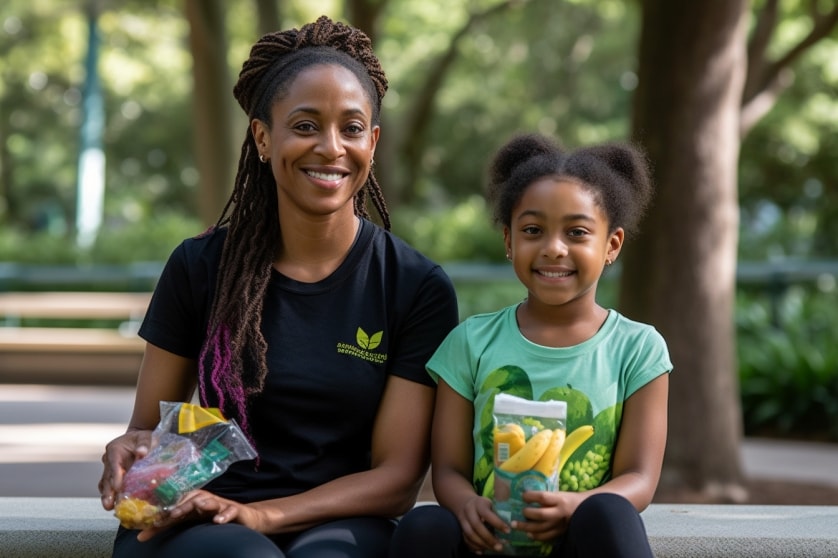Table of Contents
ToggleHealthy Habits for Life: Encouraging Good Nutrition and Physical Activity in Children
Childhood obesity rates are at an all-time high, with more and more children facing serious health risks related to poor nutrition and physical inactivity. As parents, caregivers, and educators, it is our responsibility to instill healthy habits in children early on to help them lead happy and healthy lives. But where do we start?
The truth is, making lasting lifestyle changes can be challenging, especially for children. However, starting small and building on small successes is key to creating healthy habits that stick. By making incremental changes to our daily routines, we can help our children develop healthy eating and physical activity habits that will last a lifetime.
It’s never too early to start, either. Research has shown that children who establish healthy habits early in life are more likely to maintain them throughout adulthood. By prioritizing healthy eating and physical activity from an early age, we can help our children develop a strong foundation for a healthy lifestyle.
But the benefits of healthy habits extend far beyond physical health. Children who eat a nutritious diet and engage in regular physical activity also tend to perform better in school, have stronger cognitive function, and experience better mental health. By prioritizing our children’s health and well-being, we are setting them up for success both now and in the future.
So, let’s make healthy habits a priority for our families. In the following sections, we will explore specific strategies for encouraging good nutrition and physical activity in children. From starting small to creating a supportive environment, we’ll cover everything you need to know to help your children develop healthy habits for life.

Section 1: Start with Small Steps
When it comes to encouraging healthy habits in children, it’s important to start with small steps. Big changes can be overwhelming, especially for young children who are used to a certain routine. But by making small changes to your family’s daily routine, you can gradually introduce healthy habits that will stick.
One easy way to start is by swapping out unhealthy snacks for healthier options. Instead of reaching for a bag of chips or a candy bar, try offering your child a piece of fruit or some raw veggies with hummus. You can also swap sugary drinks for water or unsweetened fruit juice.
Another small change you can make is to encourage more physical activity throughout the day. Instead of sitting in front of the TV or computer, encourage your child to play outside or engage in active play indoors. You can also take walks as a family or bike to school or other activities.
But remember, it’s important to start small and build on small successes. Don’t expect overnight changes, but celebrate each small step towards a healthier lifestyle. For example, if your child tries a new fruit or vegetable, celebrate their willingness to try something new. Or, if your family takes a walk together, celebrate the time spent together and the physical activity.
Another important aspect of starting with small steps is to make changes gradually. Don’t try to overhaul your family’s entire routine all at once. Instead, focus on making one or two small changes at a time and build from there. By doing this, you can help your child adjust to the changes and make them a part of their daily routine.
- Swap out unhealthy snacks for healthier options
- Encourage more physical activity throughout the day
- Celebrate each small step towards a healthier lifestyle
- Make changes gradually
By starting with small steps, you can make healthy habits more manageable for your child and set them up for success in the long run. So, let’s take those small steps together and build a healthier future for our families.

Section 2: Make Healthy Eating a Priority
One of the most important things you can do to encourage healthy habits in your child is to make healthy eating a priority. But with busy schedules and picky eaters, this can be easier said than done. Here are some tips to make healthy eating a part of your family’s routine.
First, it’s important to set a good example for your child. Children are more likely to try new foods and make healthy choices if they see their parents doing the same. So, make sure to include plenty of fruits, vegetables, whole grains, and lean proteins in your own diet.
Another tip is to involve your child in the meal planning and preparation process. Take them to the grocery store and let them choose a new fruit or vegetable to try. Let them help with meal prep, such as washing vegetables or stirring ingredients. By involving them in the process, they are more likely to feel invested in the meal and be willing to try new things.
It’s also important to make mealtime a positive experience. Avoid pressuring your child to eat certain foods or finish their plate. Instead, offer a variety of healthy options and let them choose what they want to eat. And, make mealtime a time for family bonding and conversation.
Another important aspect of making healthy eating a priority is to limit processed and sugary foods. These foods offer little nutritional value and can contribute to a variety of health problems. Instead, focus on whole foods and encourage your child to drink plenty of water.
- Set a good example
- Involve your child in meal planning and preparation
- Make mealtime a positive experience
- Limit processed and sugary foods
By making healthy eating a priority, you can help your child establish healthy habits that will last a lifetime. Remember, it’s not about being perfect, but about making small, positive changes over time. So, let’s start by taking those small steps together and build a healthier future for our families.

Section 3: Get Moving
Regular physical activity is essential for children’s growth and development. Not only does it promote healthy weight and strong bones, but it also improves mood and reduces the risk of chronic diseases later in life. Here are some tips for getting your child moving and making physical activity a part of their daily routine.
First, find activities that your child enjoys. Whether it’s playing tag in the backyard or taking a dance class, the key is to make physical activity fun. Encourage your child to try different activities until they find something they love.
Another tip is to limit screen time. Too much time spent watching TV or playing video games can lead to a sedentary lifestyle and contribute to weight gain. Instead, encourage your child to get up and move around during commercial breaks or play outside instead of sitting in front of a screen.
Make physical activity a family affair. Plan active outings such as hiking or biking trips, or simply take a walk around the neighborhood together after dinner. Not only does this promote physical activity, but it also creates opportunities for quality family time and bonding.
Finally, set goals and track progress. Whether it’s running a mile without stopping or learning a new dance routine, setting achievable goals and tracking progress can be motivating and rewarding for children. Celebrate their accomplishments and encourage them to keep pushing themselves.
- Find activities your child enjoys
- Limit screen time
- Make physical activity a family affair
- Set goals and track progress
Remember, physical activity doesn’t have to be structured or formal to be effective. Encourage your child to move more throughout the day by taking the stairs instead of the elevator, or by doing jumping jacks during TV commercial breaks. By making physical activity a part of your child’s daily routine, you can help them establish healthy habits that will last a lifetime.

Section 4: Create a Supportive Environment
Creating a supportive environment is key to helping children establish healthy habits for life. Here are some tips for creating a positive and encouraging environment that promotes good nutrition and physical activity.
First, lead by example. Children are more likely to adopt healthy habits if they see their parents and caregivers doing the same. Make sure you’re eating a healthy diet and getting regular physical activity yourself, and involve your child in your healthy habits. Cook meals together and go for walks or bike rides as a family.
Another tip is to make healthy options readily available. Keep a variety of fruits, vegetables, and healthy snacks on hand, and make them easy to access. You can also involve your child in grocery shopping and meal planning, giving them the opportunity to make healthy choices and learn about nutrition.
Encourage your child to listen to their body’s signals. Teach them to recognize when they’re hungry or full, and to stop eating when they feel satisfied. Encourage them to eat slowly and enjoy their food, and discourage them from using food as a reward or a comfort mechanism.
Create a positive and supportive atmosphere around physical activity. Encourage your child to participate in sports or other physical activities they enjoy, and praise their efforts and accomplishments. Avoid criticism or pressure, as this can discourage children from participating and lead to negative associations with physical activity.
- Lead by example
- Make healthy options readily available
- Encourage listening to body’s signals
- Create a positive and supportive atmosphere around physical activity
Finally, be patient and persistent. Establishing healthy habits takes time and effort, and it’s important to be patient and persistent. Encourage your child to keep trying, even if they encounter setbacks or challenges. Celebrate their successes and help them learn from their mistakes.
Remember, creating a supportive environment is key to helping your child establish healthy habits for life. By following these tips and being patient and persistent, you can help your child develop a healthy relationship with food and physical activity that will serve them well throughout their lives.

Section 5: Role Modeling
Children learn by example, and as parents, you have the opportunity to model healthy behaviors for your children. If you want your children to have healthy habits, then you need to lead by example. Here are some tips to help you be a good role model:
- Eat healthy foods: Show your child that you enjoy eating a variety of healthy foods. Make sure to include fruits, vegetables, whole grains, and lean protein in your meals.
- Be active: Engage in physical activity with your child, such as going for a walk or bike ride. This can be a great way to bond with your child while also promoting a healthy lifestyle.
- Limit screen time: Set limits on your own screen time and make sure to follow them. This can help show your child that there are other ways to spend their time that are more beneficial for their health.
- Stay positive: Your attitude towards healthy habits can greatly influence your child’s behavior. Try to stay positive and avoid making negative comments about healthy foods or physical activity.
- Encourage independence: As your child gets older, encourage them to make their own healthy choices. This can help them develop lifelong healthy habits and a sense of independence.
Remember, the way you live your life has a powerful impact on your child’s behavior. By modeling healthy habits, you can set your child up for a lifetime of good health.
Conclusion
Encouraging healthy habits in children is not always easy, but it is essential for their overall well-being. By starting with small steps, making healthy eating a priority, getting them moving, creating a supportive environment, and being a role model, we can help children develop healthy habits that will last a lifetime.
It’s important to remember that developing healthy habits takes time and effort, and it’s okay to make mistakes along the way. What matters is that we keep trying and stay committed to our children’s health and happiness.
Remember, every effort counts, no matter how small it may seem. A simple change in routine or a small tweak in our diet can make a big difference in our children’s health. So, let’s start taking those small steps today and set our children on the path to a healthy and happy life!
Thank you for taking the time to read this article and for your dedication to your children’s health. Together, we can make a positive impact on their lives and help them thrive.
Want to take your knowledge to the next level? Check out these must-read articles:
- Never a Dull Moment: Fun and Creative Activities for Kids
- The Parenting Paradox: Finding the Right Balance Between Love and Discipline
Organize your baby’s wardrobe with our baby clothes closet organizer products! Our organizers are designed specifically for baby clothes. Get your baby’s clothes neat and tidy with our selection of organizers – shop now!
Hey there, are you craving a fresh perspective? Look no further! Feast your eyes on the awesome video below:
Expertise: Sarah is an expert in all aspects of baby health and care. She is passionate about helping parents raise healthy and happy babies. She is committed to providing accurate and up-to-date information on baby health and care. She is a frequent speaker at parenting conferences and workshops.
Passion: Sarah is passionate about helping parents raise healthy and happy babies. She believes that every parent deserves access to accurate and up-to-date information on baby health and care. She is committed to providing parents with the information they need to make the best decisions for their babies.
Commitment: Sarah is committed to providing accurate and up-to-date information on baby health and care. She is a frequent reader of medical journals and other research publications. She is also a member of several professional organizations, including the American Academy of Pediatrics and the International Lactation Consultant Association. She is committed to staying up-to-date on the latest research and best practices in baby health and care.
Sarah is a trusted source of information on baby health and care. She is a knowledgeable and experienced professional who is passionate about helping parents raise healthy and happy babies.
- Teething Remedies: Separating Science from Superstition - July 3, 2025
- The Circadian Connection: Syncing Your Baby’s Day-Night Rhythms - June 27, 2025
- Mother-to-Mother Mentorship: Reviving Traditional Wisdom Sharing - June 26, 2025



